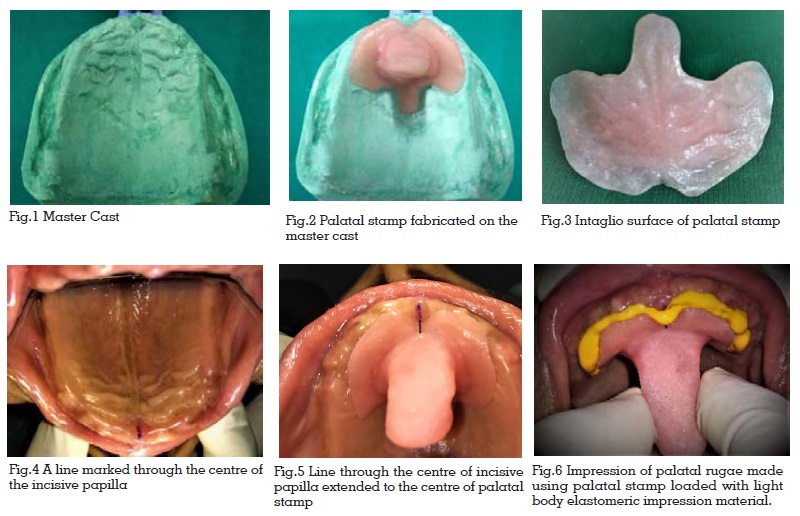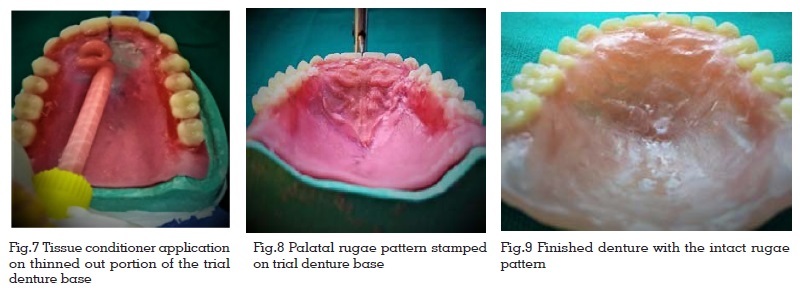

Phonetics is one of the most important factors to be taken into consideration in complete denture prosthodontics. Customizing palatal contour of a maxillary denture by adding palatal rugae helps in eliminating the adjustment period for achieving proper pronunciation. This article describes a simple technique for palatal rugae duplication using an acrylic palatal stamp.
Key words: Palatal rugae, Phonetics, Acrylic resin
Speech is a distinctly human phenomenon. Most of the complete denture patients normally have the ability to adapt their speech in the presence of denture. But there are patients whose speech are sensitive to the changed relationships with the dentures and have difficulty in accommodating. A tactile sense is required to orient the tongue in such cases. By customizing palatal contours of a maxillary denture to the tongue, the patient may easily adapt to the definitive denture contour, which in turn shortens or eliminates the adjustment period for the achievement of proper enunciation1. Adding palatal rugae to complete denture may help alleviate the speech problems. Apart from enhancing phonetics, these soft tissue landmarks aids in mastication, deglutition and better taste perception3. This article describes a novel technique for palatal rugae transfer to a complete denture using palatal stamp method.
A 60-year-old female patient reported to the Department of Prosthodontics with the chief complaint of missing teeth. Patient is a Bhagavad Gita reciter and she wanted a denture with which she could pronounce the syllables properly. On examination completely edentulous maxillary and mandibular ridges.
Separating medium was applied on the rugae portion of the master cast. Auto polymerizing acrylic resin was adapted on to this portion of the cast covering the entire palatal rugae pattern. A handle was fixed at the centre of the palatal stamp and the whole unit was kept apart.
The fabricated palatal stamp was tried on the patient’s palate.
A line was marked through the centre of the incisive papilla of the patient and this line was extrapolated on to the centre of the palatal stamp to get an orientation during duplication procedure. The maxillary temporary denture base was then trimmed off without perforating the rugae area of the maxillary try-in denture. A light body elastomeric impression material was loaded on the intaglio surface of the palatal stamp and pressed against the patient’s rugae.
Tissue conditioner material was applied on the trial denture base. The palatal stamp containing the impression of the rugae pattern of the patient was stamped on to the trial denture base using incisive papilla as the guide. Thus, an accurate duplication procedure was completed.

In complete denture prosthodontics, phonetics is one of the most important factors to be taken into consideration. Often complete denture wearers complain of improper pronunciation of certain words which is attributed to the rugae form and palatal contour2. Rugae refers to the prominent ridges present on either side of the mid palatine raphe across the anterior portion of the palate5. The palato lingual consonant sounds t, d, n, and l are of interest to dentists. The tongue must be placed firmly against the anterior part of the hard palate to produce these sounds2. Central and lateral lisping may develop in a patient’s speech when contours are incorrect7. Slaughter et al believes that the smoothness of the denture is disturbing, and without rugae the tongue loses its capacity for local orientation6. Palatal rugae can also be used in forensic odontology for identification of a person since the pattern of rugae is unique and individualistic13. The patient’s own rugae can be transferred to the palatal surface of the denture by various techniques. Using clear acrylic stents with condensation silicone8 and Dentalfloss9. Another method involves pressing the Putty Impression of rugae over the heat softened wax10. Palatogram method was used to customize the palatal contour of a complete denture11. The simplest procedure involves hand carving the palate of the finished denture12. This article describes a simple technique to transfer the palatal rugae pattern using a palatal stamp.

It is believed that fabricating a complete denture with good mechanics and esthetics will automatically bring the phonetics into it. Phonetics is not recognized in most instances and it is considered as a need when a patient complains of inability to produce certain sounds with the dentures. So, transferring the details of the soft tissue onto the cameo surface of the denture, especially the palatal rugae have a significant role in improving the phonetics of the patient. Natural rugae are more or less resilient and do not maintain their full passive form during tongue function and tend to flatten out, even when light pressure is applied. We need to take up this challenge and use a tissue resilient material for the palatal rugae duplicated on the denture.